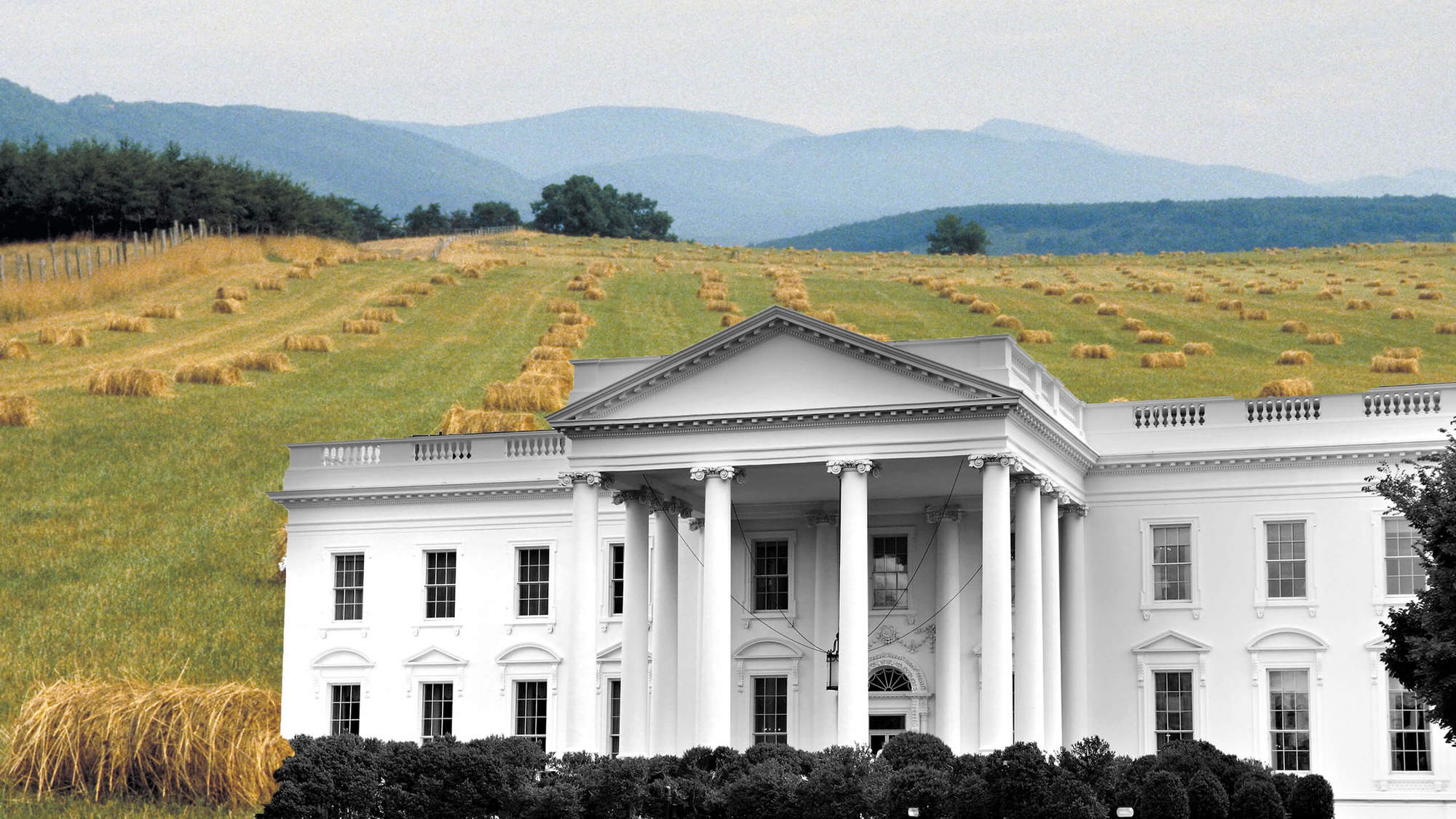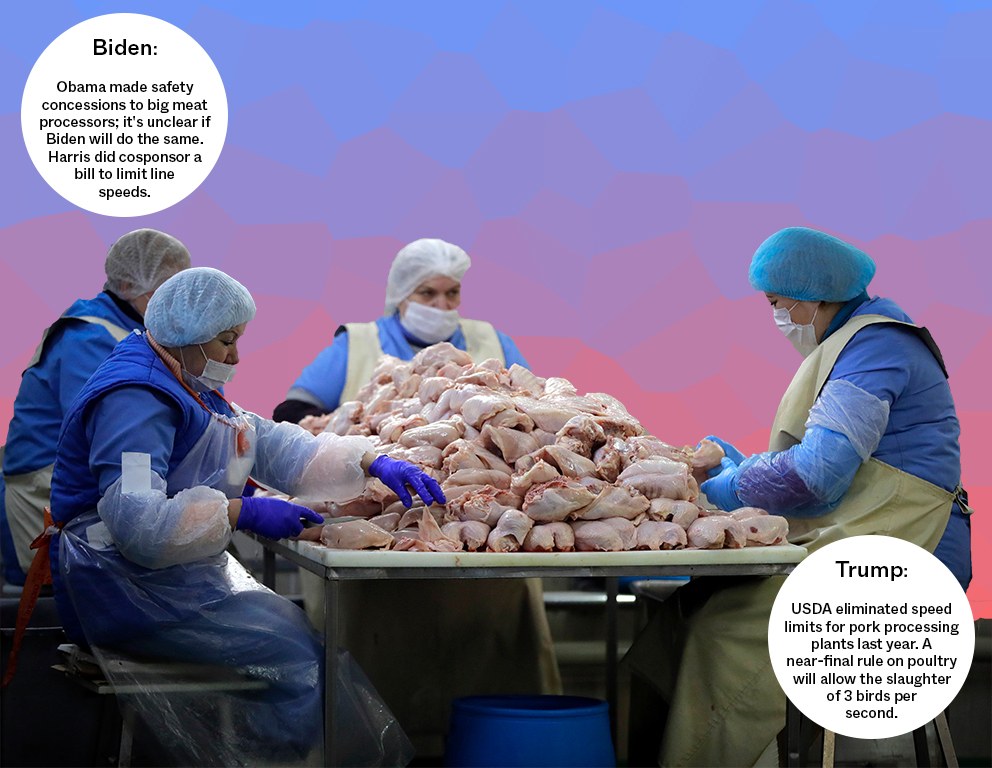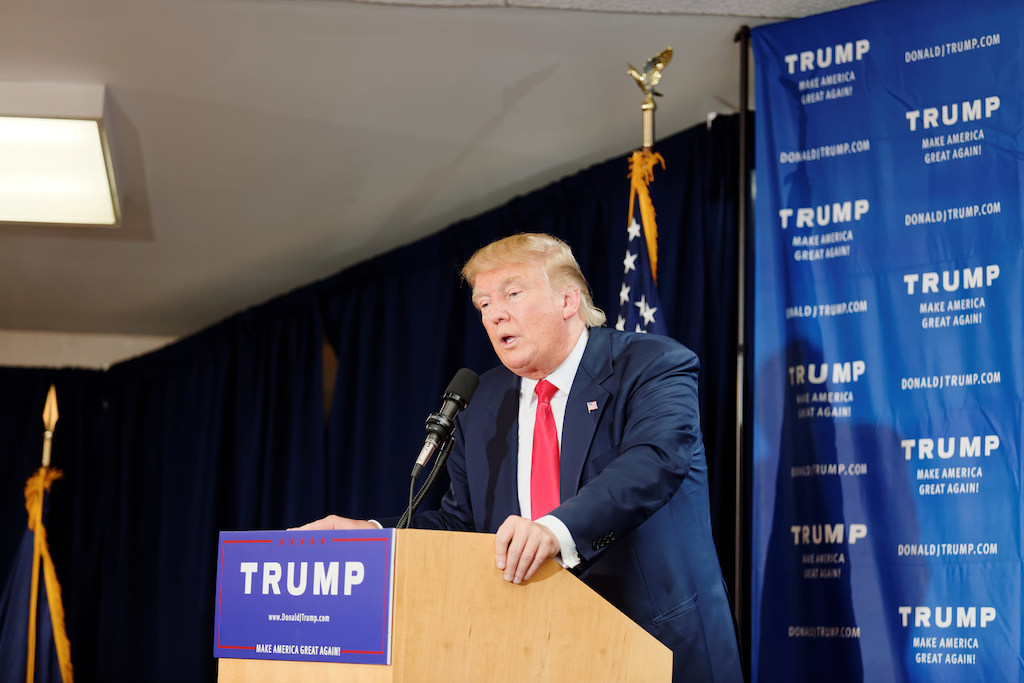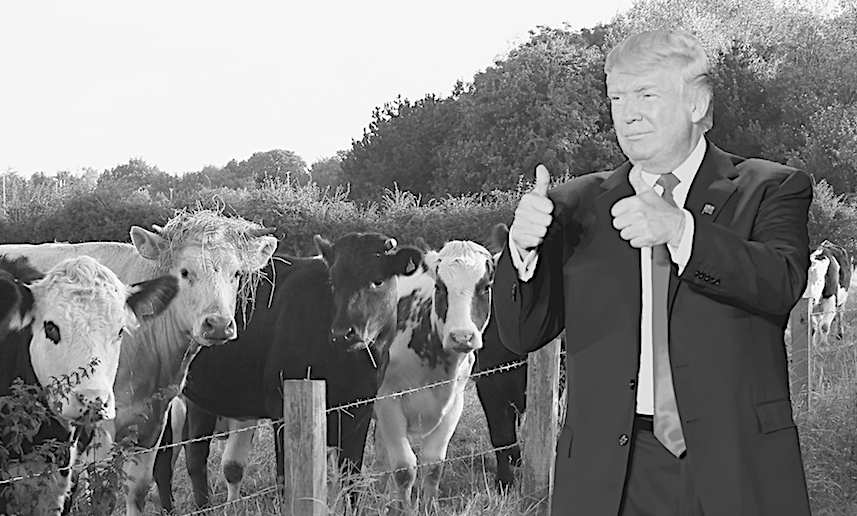
iStock / tupungato, USDA, Graphic by Tricia Vuong
The Counter’s guide to Trump’s signature rollbacks—and our predictions on their survival in 2021.
Here’s a post-election reality check for these abbreviated, early-winter days: Congress will still be narrowly divided when President-elect Joe Biden takes office in January. He’ll face two sprawling bureaucracies central to food and farm policy that have been dramatically weakened during President Trump’s tenure. The agriculture department (USDA) and Environmental Protection Agency (EPA), both hollowed out by mass employee exoduses earlier this year, were demoralized by the record losses.
But as President Trump has demonstrated throughout his White House tenure, the commander-in-chief can still get a lot done on his own.
Under the current administration, USDA has authorized tens of billions of dollars in direct payments to farmers to mitigate the damages of Trump’s trade disputes—all with little oversight. It has used obscure rules to deter potential green card applicants from seeking food assistance. And it has chipped away at the Supplemental Nutrition Assistance Program (SNAP), one arcane adjustment at a time.
Because many Obama-era food and farm reforms were implemented toward the end of his tenure, the Trump administration had a relatively easy time retracting rules that were never implemented.
The regulatory rollback spree commenced almost immediately after President Trump’s January 2017 inauguration. It’s not uncommon for incoming administrations to undo some of their predecessors’ controversial initiatives: during his first 100 days, President Obama rolled back Bush II-era policies that limited the power of unions, and lifted a ban on stem-cell research. And because many Obama-era food and farming reforms were implemented toward the end of his tenure, the incoming Trump administration had a relatively easy time retracting rules that were never implemented, including those that protected contract farmers and established animal welfare standards for organic meat.
In February, President Trump signed an executive order aimed at dismantling a provision of the Clean Water Act long maligned by influential farm groups. Shortly after, USDA published an interim final rule that relaxed some of the school nutrition standards championed by former First Lady Michelle Obama.
[Subscribe to our 2x-weekly newsletter and never miss a story.]
In January 2021, President-elect Biden will have the opportunity to roll back the rollbacks, to re-regulate the de-regulated. These are changes he can make without the aid of Congress; Senate Majority Leader Mitch McConnell may slow down the process of confirming his Secretary of Agriculture, but his reach doesn’t extend to the rulemaking process.
In many cases, Biden won’t have to do much to ensure the Trump administration’s most controversial food and farming policies never see the light of day. In others, he’ll need to go to court or issue executive orders. Still more will require Congressional action or a lengthy rulemaking process.
Here’s your guide to the Trump administration’s signature rollbacks—and our predictions on their survival in 2021.
Make SNAP restrictive again
The rules, in 10 words: Tighten rules for food assistance, making it harder to access.
Current status: The administration introduced three rules aimed at shrinking the SNAP in 2019. One has been struck down in federal court, and the other two have not been finalized.
Projected impact: If fully implemented as proposed, the rules would boot nearly 4 million participants from the SNAP rolls. The first would do so by subjecting more people to work requirements. The second would end flexibilities that allow states to loosen eligibility restrictions for participants who have assets like savings accounts, cars, or homes, and raise the program’s gross income limit. The third would modify allowable utility expense deductions.
Lovers: Fiscal conservatives, advocates of welfare reform.
Haters: Anti-poverty groups, Democrats, food banks.
The Trump administration hasn’t been successful in realizing any of its proposed modifications to SNAP, despite lots of rhetoric about shrinking the safety net.
Likelihood of a Biden rollback: High—if he has to do anything at all. If the Trump administration doesn’t appeal the federal lawsuit quashing its work requirement rule by January, it’ll be dead on arrival. (If it does appeal the lawsuit, the Biden administration could simply drop the appeal.) Similarly, if USDA doesn’t publish final rules for the eligibility and utility deduction standards, the Biden administration will be able to drop the proposals.
The Trump administration hasn’t been successful in realizing any of its proposed modifications to SNAP, despite lots of rhetoric about shrinking the safety net. “It certainly didn’t get anywhere near where it appeared to want to go,” said Ed Bolen, senior policy analyst with the Center on Budget and Policy Priorities.
Yet the administration did succeed in making the program “less friendly,” he added. Consider the controversial “public charge” rule, for instance, which would have allowed customs officials to consider green card seekers’ use of SNAP and other public benefits when assessing their applications. While the rule is facing robust court challenges and it’s unclear to what extent officials are actually considering SNAP use as a factor in their decisions, some research has indicated the mere threat of the rule had a chilling effect on program enrollment among immigrant communities.
Salt, fat, refined grains, heat
The rules, in 10 words: Loosen school nutrition standards championed by Michelle Obama.
Projected impact: USDA has issued two proposals that would make school meals saltier, fattier, and higher in empty calories. The first would do away with Obama-era sodium reduction targets, halve whole-grain serving requirements, and re-introduce one-percent milk in schools. The second would decrease the amount of fruit that schools are required to offer for breakfast, while increasing the amount of starchy vegetables like white potatoes and corn they could offer in a single week.
Lovers: School lunch administrators; food manufacturers.
Haters: Public health advocates.
Current status: A federal judge struck down the first proposal on procedural grounds in April, though it appears that USDA is making a last-ditch attempt to usher an identical rule through at this very moment. The second proposal hasn’t moved forward under the standard rule-making process, however, USDA effectively implemented it via an emergency waiver, which justified the de-regulation as necessary in light of pandemic-related supply chain contractions.
Likelihood of a Biden rollback: Fairly likely. If the Trump administration finalizes either of these proposals before January 20, Biden’s administration would have to initiate standard rule-making procedures to roll them back. And it would have to do so quickly in order to give nutrition directors time to adjust how they source and plan school meals through the end of the school year and beyond.
It will also be up to Biden to decide which of USDA’s other Covid-related waivers to extend, most notably one that allows all kids access to school meals at no cost through the 2020-2021 academic year. School nutrition directors are demanding that this waiver be extended until the public health crisis is over, while the Trump administration has been reluctant to renew it for more than a few months at a time.
Put America’s water last
The rules, in 10 words: Shrink the definition of federally protected waters.
Projected impact: The Navigable Waters Protection Rule removes over 50 percent of the nation’s wetlands and nearly 20 percent of streams and rivers from federal protection. It’s the largest rollback of the Clean Water Act since the law was passed in 1972. The new water law, which no longer requires a permit to release pesticides and other pollutants into those waterways, directly impacts the food system: the cost of drinking water, the quality of craft beer, the protection of oysters and crabs in downstream fisheries, and the safety of irrigated lettuce and spinach, among others.
Lovers: The Farm Bureau, and other lobbies that represent homebuilding, mining, and oil and gas industries. Republican lawmakers from Kansas, Nebraska, North Dakota, and Iowa.
Haters: Environmentalists.
“There have been 50 years of debate about which waterways are considered Waters of the United States. Without Congressional action to clarify that, it’s almost inevitable that the Supreme Court will be weighing in on the legality of whatever rule ends up in place.”
Current status: Effective as of June 22, 2020.
Likelihood of a Biden rollback: Likely. Biden has pledged to “tackle water pollution in a science-based manner” and improve water quality. Lynn Scarlett, chief of external affairs at The Nature Conservancy, and President George W. Bush’s deputy interior secretary, expects Biden to rescind and replace President Trump’s rule with one that resembles President Obama’s Waters of the United States rule (WOTUS), which covered 60 percent of American waterways, including wetlands that are not adjacent to large bodies of water, some seasonal streams, and groundwater.
Whether the Biden administration reverts to the Obama-era rule, or crafts its own definition of federal waters, the ultimate decision is likely to be made in court, says Tarah Heinzen, an attorney at Food & Water Watch, one of several groups suing the Trump administration over its rule. “There have been 50 years of debate about which waterways are considered Waters of the United States,” said Heinzen. “So without Congressional action to clarify that, I think it’s almost inevitable that the Supreme Court will be weighing in on the legality of whatever rule ends up in place.”
High-speed chase
The rules, in 10 words: Raise line speed limits at poultry and pork processing plants.
Current status: USDA’s final rule on poultry line speeds is expected any day now. The agency eliminated speed limits for pork processors last year.
Projected impact: The rules would allow poultry processors to slaughter up to three birds per second and have eliminated line speeds altogether for the pork industry. Food and worker safety advocates have argued that faster speeds make unsafe meat harder for inspectors to spot, and injuries harder for employees to prevent.
Lovers: The chicken industry, the pork industry: The National Chicken Council formally asked for the line speed change in 2017, and heavy hitters like Tyson Foods, Wayne Farms, and Mountaire Farms
Haters: Worker safety advocates, food safety groups like Food & Water Watch.

AP Photo/Sergei Grits | Graphic by Talia Moore
Likelihood of a Biden rollback: Unclear! As Mother Jones notes, the Obama administration gave poultry companies a lot more power to inspect their own plants, and even considered allowing faster line speeds (though ultimately decided against it). But that was life before the coronavirus…
Since then, Vice President-elect Kamala Harris co-sponsored a Senate bill limiting line speeds for the duration of the Covid-19 pandemic. “The USDA should be in the business of prioritizing worker and consumer safety over the profits of large multinational meatpacking corporations, not the other way around,” said Senator Cory Booker, who introduced the bill, at a recent consumer advocacy conference. The current USDA, meanwhile, has taken a piecemeal approach to lifting line-speed limits at poultry slaughterhouses, issuing waivers to individual processing plants as they apply.
During the pandemic, USDA has angered food safety and worker advocates by granting these waivers during a global health crisis. The industry has argued that it should be allowed to produce as much as possible, threatening meat shortages when faced with pressure by local authorities to shutter plants due to Covid-19 outbreaks. Critics of the waivers say faster line speeds can increase overuse injuries. and contribute to the spread of Covid-19 by. According to the National Employment Law Project, all of the plants that have been granted line speed waivers have reported severe injuries among workers in recent years.
Assuming USDA does allow poultry plants to process 175 birds per minute before the inauguration, the Biden administration could withdraw the rule (though again, it’s not clear that it would). The new administration could also revoke processing plants’ individual waivers or tie waiver eligibility to worker safety standards. The rule that eliminated speed limits at pork plants has already gone into effect.
Heinzen, of Food & Water Watch, which has sued USDA to overturn the pork rule, said she hopes Biden’s USDA will slow speeds in both the poultry and pork industries. “I expect the Biden administration will be interested in ensuring food safety measures and ensuring that we have appropriate federal inspections of slaughterhouses, especially in this era of Covid,” she said.
Thoughts and (s)prayers
The rules, in 10 words: Roll back Obama-era prohibitions on use of disputed pesticides.
Projected impact: The Trump administration has allowed use of numerous controversial farm chemicals that public interest groups want banned: chlorpyrifos, which has been linked to brain damage in children and farm workers; dicamba, notorious for its tendency to drift and kill wildlife and crops on neighboring farms, and neonicotinoids, which have been linked to pollinator decline and disruption of bird migration.
Lovers: Commodity farmers; seed and agrochemical producers.
Haters: Environmental and public health advocates.
“The Biden administration should take a very hard look at refuge agriculture and at the very least say that all agriculture on national wildlife refuges should be organic.”
Current status: Environmental and public interest groups, including the Center for Biological Diversity and the Center for Food Safety, have repeatedly taken the Trump administration to court over its rollbacks, to little success so far. A federal judge in September dismissed a lawsuit to maintain the neonicotinoid ban. Meanwhile, EPA has signaled that it will continue the process of re-registering both chlorpyrifos and dicamba for use in the years to come.
Likelihood of a Biden rollback: Somewhat likely. Environmental advocates are not only calling on the Biden administration to reinstate the neonicotinoid ban, but to go further in restricting pesticide use on protected public lands by banning the use of all pesticides.
“Rather than just saying we’re immediately going back to the ban on [genetically engineered] crops and neonicotinoids on wildlife refuges, I think [the Biden administration] should take a very hard look at refuge agriculture and at the very least say that all agriculture on national wildlife refuges should be organic,” said Lori Ann Burd, senior attorney and environmental health program director at the Center for Biological Diversity, an environmental group that advocates for the protection of endangered species.
Proponents of the bans, as well as farmers whose crops have been damaged by pesticide drift, are also looking to the Biden administration to cancel registration proceedings for dicamba and chlorpyrifos.
Biden’s EPA will likely face little opposition if it chooses to ban chlorpyrifos. The largest producer of the pesticide already phased out its production after years of declining demand. With dicamba, however, it may face pushback from commodity producers who call the herbicide their last resort against resistant weeds.
Logging on
The rules, in 10 words: Open sacred Native American land to ranching, mining, and logging.
Projected impact: In shrinking Bears Ears, a national monument in Utah established by President Obama, by over a million acres, President Trump endangered the ability of the Navajo Nation and four other Native American tribes to gather piñon pine nuts, plants, and other herbs they have used for millennia. Similarly, by opening 9 million acres in Alaska’s Tongass National Forest to logging, Trump threatened the long-term future of North America’s largest carbon sink—and the variety of berries, medicines, mushrooms, and fish that five tribal nations still rely on.
Lovers: The National Cattlemen’s Beef Association, a trade association representing cattle ranchers and beef companies; uranium miners; old-growth loggers; Republican elected officials.
Haters: Environmentalists; 10 Native American tribes and nations, including the Navajo, Ute, Hopi, Tlingit and Haida.
Current status: Effective as of February 2018 for Bears Ears, and October 29, 2020 for Tongass.
Likelihood of a Biden rollback: Very likely. President-elect Biden has been clear about his intentions to support Native Americans in their food sovereignty efforts. According to the Biden-Harris Plan for Tribal Nations published on Biden’s website, on his first day in office, future-President Biden will issue an executive order to conserve 30 percent of American land and waters, part of an effort to “reverse the Trump administration’s assaults on America’s natural treasures.” He specifically named Bears Ears as part of that effort.
Restoring protections to the Tongass, however, can’t be done through the stroke of a pen, but instead through regulations, which some Alaskan politicians are already bracing for. Scarlett, the former deputy interior secretary, says that won’t happen immediately. “Trump unraveled well over 100 regulations, and took other actions, to modify environmental protections,” she said. “The new administration will have to do some prioritizing.”












